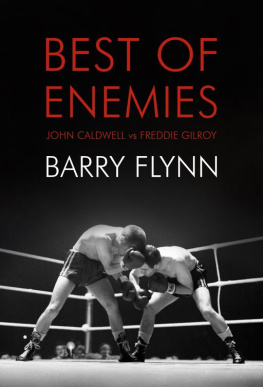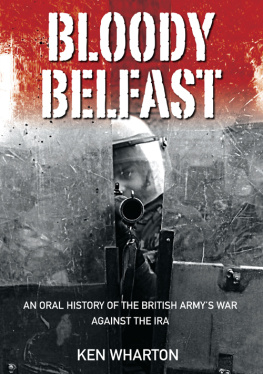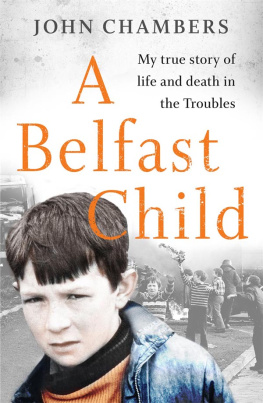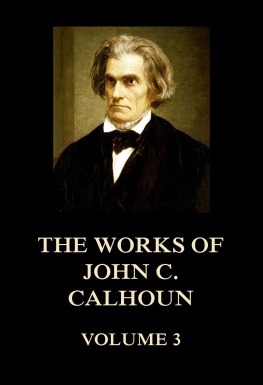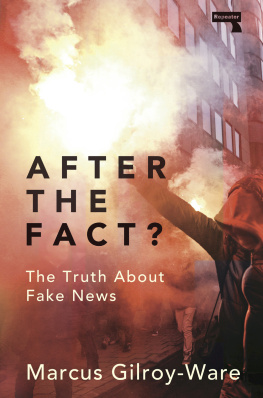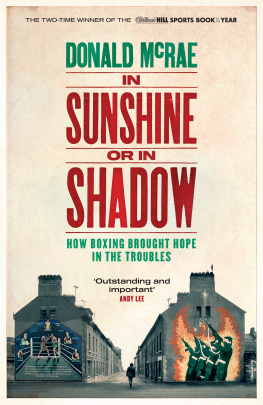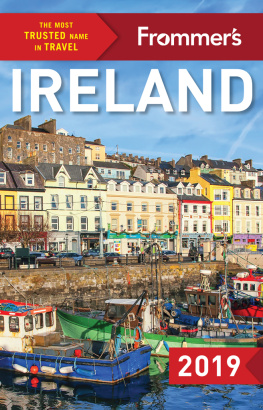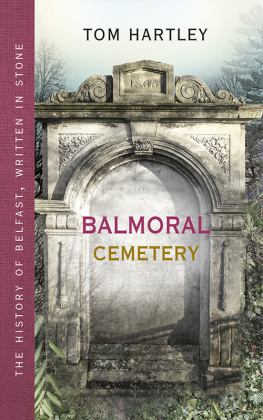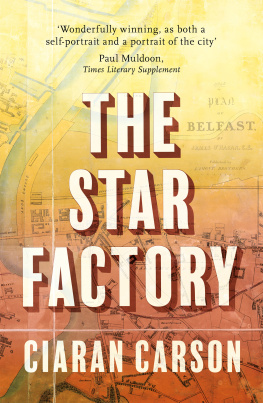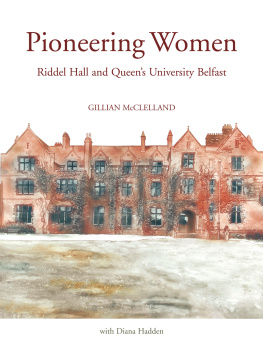I would wish to thank Freddie and Bernie Gilroy and the Caldwell family for their assistance in writing this book, particularly Paul and Bridie Caldwell. Teddy Gilroys scrapbook on his brother was a true joy to behold, and I thank him for letting me access it. I would mention also Johns daughters, Patricia Burns and Berna McStravick, for their recollections of their late father. Jim McCourt and Harry Enright were most helpful with their memories of the Immaculata boxing club. To Eamon McAuley, Hugh Jordan, Brian Madden, Liam McBrinn, Jimmy Donnelly and Davy Larmour, I would record my sincere thanks. I would also like to thank my father, Anthony Flynn, for his guidance. Finally, I would pay tribute to the staff of Liberties Press for their help and advice in the writing of this book.
A Solitary Man
It is a typically dark and wet Belfast Friday night in November 2005. Alone at the bar in the Fruithill bowling club in Andersonstown stands the solitary figure of John Caldwell. Gaunt and oblivious to his surroundings, John, amid the litter of spent cigarettes, ignores the bars satellite television as some meaningless American boxing match is played out on it. Staring at his half-empty glass, the former world champion raises his eyebrows as the barman sets him up another pint of Guinness; he nods his thanks in the direction of the man who has stood him the drink. The television blares on; John Caldwell is a lonely man who has lost interest in many things in life especially boxing.
Soon, a man in his late thirties passes by and stops with purpose. Ordering a round, the man looks up at the fight on the big screen and then at Caldwell, saying, My money would be on you, Johnny. My money would still be on you, wee man! John, fighting back his irritation, lifts his head in acknowledgement and then stares back at the bar. The man pays for his round and leaves to return to his company; John now has another pint paid for in the tap. John Caldwell is ill, but the people of Belfast will never forget a legend.
The Man in the Big Picture
On a fine spring day in 1962 in Belfasts Lower North Street, Mrs Kitty Neeson from Ballymena enters Bannons furniture shop accompanied by her ten-year-old boxing-mad son. Her young boys hero, Freddie Gilroy, works in the shop and for fresh-faced Liam Neeson it is a dream come true. Mrs Neeson makes a polite request for Freddie to pose with her son in the street for a photograph. As usual, the boxer is happy to oblige. Neeson, dressed in short trousers and an Aran jumper, stands proudly with his hero as his mother takes the snap. Liam Neeson is as pleased as punch, having shaken the hand of an Irish boxing legend.
Forty-eight years later, in the ornate surroundings of the Belfast City Hall, the two men meet up to recreate that famous photograph. The press love the story and are out in force. Asked how he feels on being reunited with his childhood hero, Neeson responds, Im still shaking. Gilroy tells the journalists that he is delighted to recreate the photograph with the Hollywood star. Hes the man in the big picture now, he says. With the famous picture recreated, Freddie Gilroy returns to his humble Belfast home, while Liam Neeson returns to New York. Among Neesons prized personal possessions is a pair of Gilroys boxing gloves.
Belfast is an unforgiving place. Built on the Bog Meadows, for centuries it has fought against geographical adversity to survive. Its people are survivors too. It is a friendly city, though, blessed with humour and kindness. It is also a city renowned, sadly, for fighting. All too often, the peace of the city has been shattered by unskilled and unregulated violence. However, when fighting is regulated in the form of boxing, Belfast can produce men of a class and level of skill that make them a match for anyone in the world. This is a tale of boxing in Belfast, of two men whose undoubted flair and ability put the city at the top of the sporting world for a time. That period was too short, but while the glory lasted both John Caldwell and Freddie Gilroy shone ever so brightly at the very pinnacle of an unforgiving sport.
Caldwell and Gilroy brought international greatness to Ireland and Belfast as both amateur and professional boxers. They were two exceptional exponents of the noble art who boxed their way to greatness the hard way. They were truly world-class. In an era of real legends, they were right up there with the very best. Between 1959 and 1962, both were listed consistently in the top ten of the world rankings. Boxing today is littered, perhaps, with questionable world champions and world championships these two men were the proverbial real deal in international terms.
For all the glory, this, however, is a tale laced also with tears, anguish and despair. The root cause of the unhappy side of their careers lay purely at the door of money. For every pound they earned as professionals, there were managers, trainers, seconds, hangers-on and greedy promoters all awaiting payment. Especially greedy promoters. What the two boxers were left with after deductions was a pale reflection of the solitude, sweat and tears they put into their sport. That is, sadly, the all-too-familiar story of professional boxing.
In October 1960, Gilroy was unlucky to lose to Alphonse Halimi for the European version of the world bantamweight title. After that defeat, Gilroy had been promised a rematch. Promoter Jack Solomons and Caldwells manager, Sam Docherty, however, sensing a succession of lucrative paydays, choose to match Caldwell then a flyweight with Halimi. Despite the protests of the Gilroy camp, Caldwell took the crown in his first outing as a bantamweight. In the week prior to Caldwells triumph, Gilroy had tasted disaster when he travelled to Brussels and lost a European title fight to Pierre Cossemyns. As Caldwell stood on top of the world, Gilroys career lay in tatters. Hindsight tells us that perhaps it could have been the other way round.
In January 1962, Caldwell journeyed to Brazil to meet the legendary der Jofre, for the right to be named the undisputed world bantamweight champion. He was well beaten on the night and his chance of immortality was gone forever. Looking back, it could be argued that by 1962 Caldwell and Gilroy had peaked as boxers and there was nothing left for them to do, except to fight each other. That inevitable battle was a truly brutal affair; like two attack dogs sprung from their leashes, they gave each other nine rounds of hate at Belfasts Kings Hall on Saturday, 20 October 1962. Gilroy won when Caldwell was forced to retire with a cut eye. That raw, spiteful fight satisfied the innate and animalistic hunger of the fifteen thousand in attendance. It most certainly satisfied in financial terms the joint promoters of the bout, Jack Solomons and George Cornell. The blood-fest of the Kings Hall was an affront to boxing and should never have happened. In rivalry, John and Freddies friendship was finished utterly.
A lucrative rematch proved to be too much for Freddie Gilroy. His weight problems became insurmountable. In reality, he was sick and tired of boxing. With a hefty fine issued at Solomonss behest, Gilroy left boxing in November 1963 a very bitter man. Caldwells career limped on until 1965 when, with a damaged nose and suspect eyes, he bid goodbye to the sport. The two Belfast men had been chewed up and spat out by the sport they had loved. They had been salmon swimming in a sea infested with hungry sharks.

